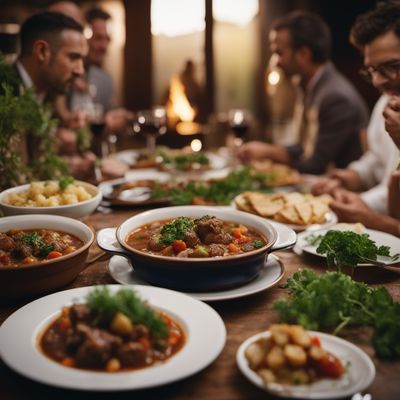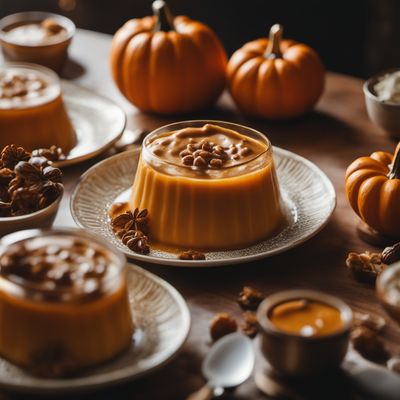
Recipe
Seada with a Twist: A Fusion of Sardinian and Palembang Flavors
Savory Sweet Fusion: Palembang-inspired Seada Delight
4.7 out of 5
Indulge in a unique culinary experience with this fusion recipe that combines the traditional Sardinian dessert, Seada, with the vibrant flavors of Palembang cuisine. This delightful dish brings together the sweetness of honey and the richness of cheese, infused with aromatic spices and a touch of Palembang's culinary heritage.
Metadata
Preparation time
30 minutes
Cooking time
10 minutes
Total time
40 minutes
Yields
4 servings
Preparation difficulty
Medium
Suitable for
Vegetarian, Nut-free, Soy-free, Egg-free, Halal
Allergens
Wheat, Dairy
Not suitable for
Vegan, Gluten-free, Dairy-free, Paleo, Keto
Ingredients
In this adaptation, we infuse the traditional Seada with the vibrant flavors of Palembang cuisine. The original recipe is modified by incorporating Palembang spices and ingredients, such as aromatic spices like turmeric and coriander, which add a distinct Southeast Asian twist to the dish. Additionally, the traditional Sardinian cheese is replaced with a local Palembang cheese, giving the filling a unique and authentic flavor. We alse have the original recipe for Seada, so you can check it out.
-
2 cups (250g) all-purpose flour 2 cups (250g) all-purpose flour
-
1/2 teaspoon salt 1/2 teaspoon salt
-
1/4 cup (60ml) water 1/4 cup (60ml) water
-
1/4 cup (60ml) olive oil 1/4 cup (60ml) olive oil
-
1 cup (200g) Palembang cheese, grated 1 cup (200g) Palembang cheese, grated
-
2 tablespoons honey 2 tablespoons honey
-
1 teaspoon ground turmeric 1 teaspoon ground turmeric
-
1 teaspoon ground coriander 1 teaspoon ground coriander
-
Vegetable oil, for frying Vegetable oil, for frying
Nutrition
- Calories (kcal / KJ): 350 kcal / 1465 KJ
- Fat (total, saturated): 15g, 6g
- Carbohydrates (total, sugars): 45g, 8g
- Protein: 10g
- Fiber: 2g
- Salt: 0.5g
Preparation
-
1.In a large mixing bowl, combine the flour and salt. Gradually add the water and olive oil, kneading until a smooth dough forms.
-
2.Divide the dough into small balls and roll them out into thin circles.
-
3.In a separate bowl, mix the grated Palembang cheese, honey, ground turmeric, and ground coriander until well combined.
-
4.Place a spoonful of the cheese mixture onto one half of each dough circle, leaving a small border around the edges.
-
5.Fold the dough over the filling, pressing the edges firmly to seal the pastry.
-
6.Heat vegetable oil in a frying pan over medium heat. Fry the pastries until golden brown on both sides.
-
7.Remove from the pan and let them cool slightly before serving.
Treat your ingredients with care...
- Palembang cheese — Make sure to use a local Palembang cheese, such as "Pempek Kapal Selam," for an authentic flavor. If unavailable, you can substitute it with a mild, semi-hard cheese like mozzarella.
Tips & Tricks
- For a sweeter variation, drizzle the fried pastries with additional honey before serving.
- Serve Seada warm for the best taste and texture.
- Experiment with different spices to customize the flavor profile to your liking.
- If the dough is too dry, add a little more water. If it's too sticky, add a sprinkle of flour.
- To save time, you can prepare the dough and filling in advance and assemble the pastries just before frying.
Serving advice
Serve the Seada as a delightful dessert or a unique snack. Pair it with a cup of hot tea or coffee to complement the flavors.
Presentation advice
Arrange the Seada on a platter, dusted with a sprinkle of powdered sugar for an elegant touch. Garnish with a few fresh mint leaves for a pop of color.
More recipes...
For Seada
For Sardinian cuisine » Browse all
More Sardinian cuisine dishes » Browse all

Magarına bulli
Magarina bulli
Magarına bulli is a classic Turkish dish that is known for its rich and creamy flavor. It is made with pasta that is cooked in a mixture of milk,...

Cutturiedde
Sardinian lamb and vegetable stew
Cutturiedde is a traditional Sardinian lamb and vegetable stew that is slow-cooked with tomatoes and herbs.

Sùgoli
Pumpkin pudding
Sùgoli is a traditional dish from Sardinia, Italy. It is a type of pasta made with semolina flour and water, and is typically served with a...








